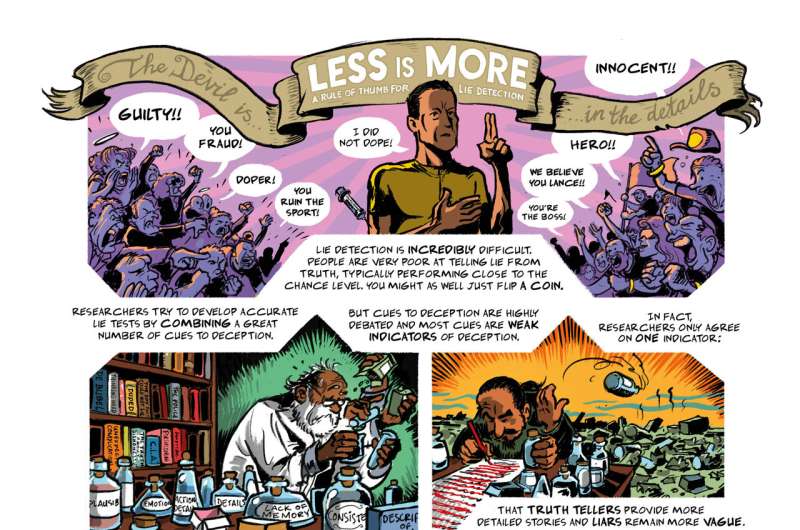This article has been reviewed according to Science X's editorial process and policies. Editors have highlighted the following attributes while ensuring the content's credibility:
fact-checked
peer-reviewed publication
proofread
A new approach to lie detection: The devil is in the details

Figuring out a lie has never been easier: forget body language or how convincing the message is, just listen to how detailed and rich the story is. This is the core of a new approach to lie detection, say researchers from the University of Amsterdam's Leugenlab (Lie Lab) in collaboration with researchers from Maastricht University and Tilburg University.
Since 9/11, security staff have been trained to recognize no less than 92 signals that someone might be lying. Bruno Verschuere, associate professor of Forensic Psychology: "This is nonsensical, because it's an impossible task. People can't assess all those signals in a short time, let alone integrate multiple signals into an accurate and truthful judgment."
"We are used to believing people who look innocent. After all, it pays to believe by default that people are good. And liars have happily exploited this fact—just remember Lance Armstrong, he had many people's sympathy for a long time," says Verschuere.
Lie researchers have therefore been recommending for some time that it is best not to rely on someone's body language, but on what they actually say. Existing verbal lie tests try to combine numerous different signals, including consistency, directness and plausibility. However, these signals do not always point in the same direction.
The devil is in the details
The Lie Lab has now come up with a new approach to lie detection in which people base their judgments on just one signal. A simple rule of thumb which focuses entirely on the level of detail in the story told by the 'liar.' It certainly takes a bit of getting used to.
"It feels very counterintuitive to just listen to what people are saying and not to pay attention to all kinds of other signals, such as how convincingly or emotionally someone conveys their story," explains Verschuere. "But people who tell the truth can give a rich description because they actually experienced the event, whereas although liars can come up with details, this increases their risk of being caught."
Unmasking liars
In order to know with 100% certainty whether someone was lying or not, the researchers conducted a series of lab experiments. A group of students was divided into guilty and innocent. Those assigned to the guilty group were instructed to steal an exam from a locker. Those in the innocent group were tasked with spending half an hour on the campus: go to the library, drink coffee and call a friend.
Afterwards, both the innocent and guilty parties were to say that they had spent half an hour on campus. In nine studies, 1,445 people were asked to rate the accuracy of honest and deceptive handwritten statements, video transcripts, video interviews or live interviews. Under the standard condition, participants were free to use all possible signals—from looking people in the eye to looking for nervous behavior or a particularly emotional story—to assess whether someone was lying.
In this situation, they found it difficult to distinguish lies from truths and scarcely performed above the level of probability. When instructed to rely only on the amount of detail (place, person, time, location) in the story, they were consistently able to discern lies from truths.
Bachelor's students from the UvA and Master's students from the UvA and the UM carried out data collection, control experiments and replication studies for the research in the context of their theses.
The research is published in the journal Nature Human Behaviour.
More information: Bruno Verschuere, The use-the-best heuristic facilitates deception detection, Nature Human Behaviour (2023). DOI: 10.1038/s41562-023-01556-2. www.nature.com/articles/s41562-023-01556-2
Journal information: Nature Human Behaviour
Provided by University of Amsterdam




















